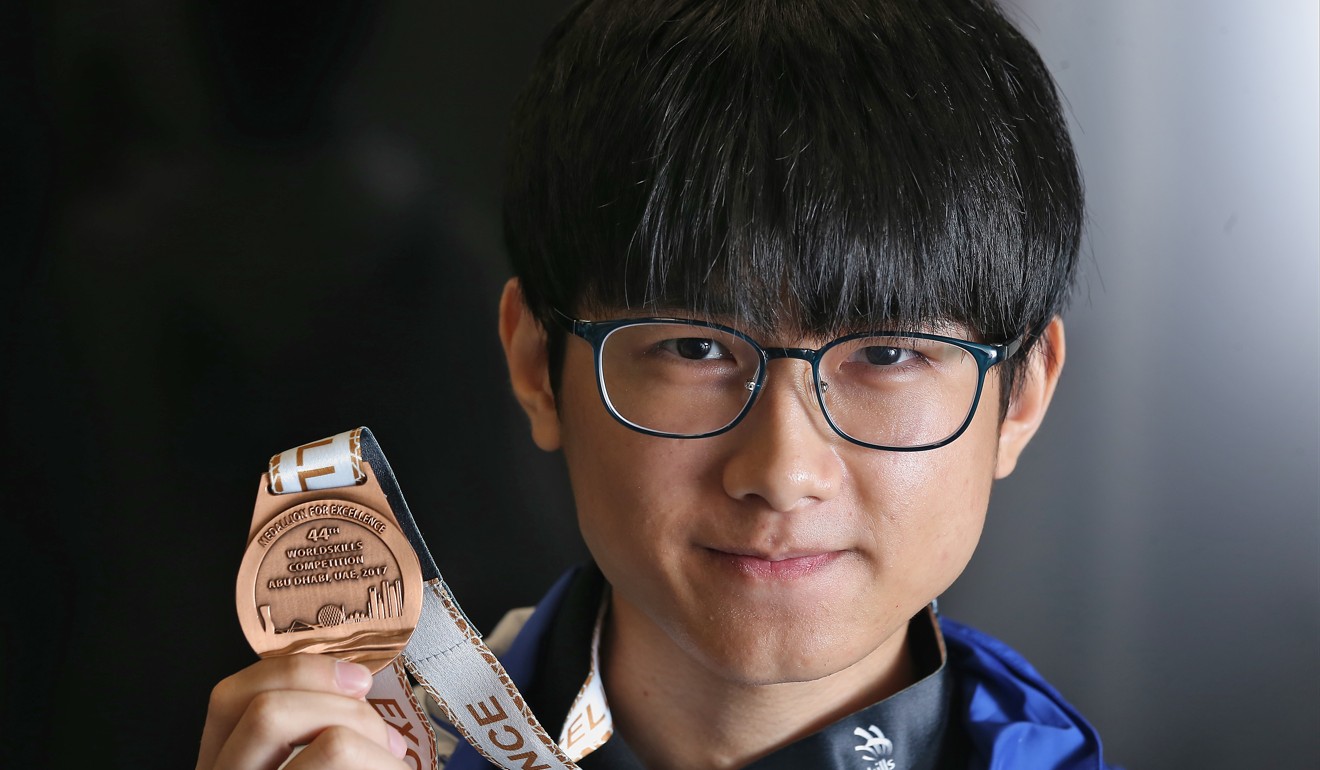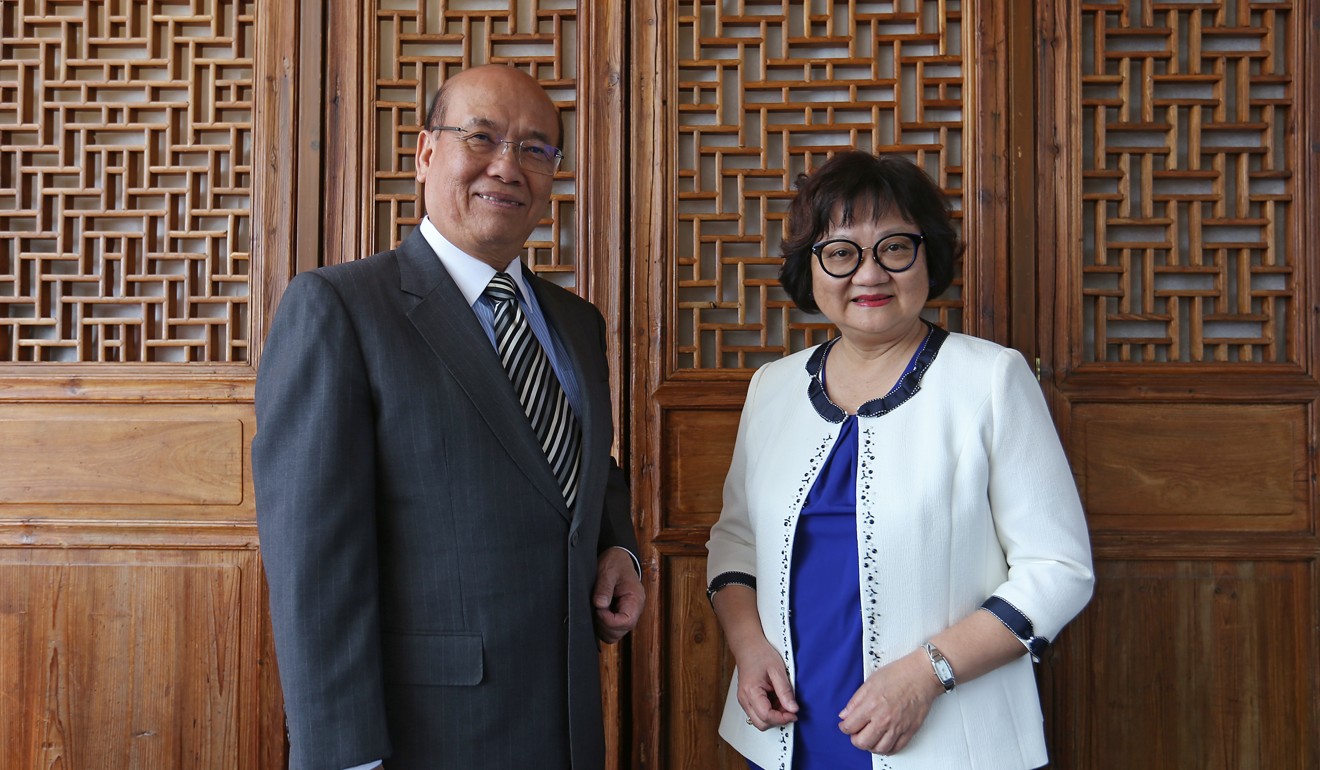
As Hong Kong lags behind competitors, vocational education needs a boost to shed ‘low class’ image
Educators say mindset change and better government funding would get more youngsters to pursue skills training to succeed in new economy

When one thinks about vocational education, blue collar trades such as plumbing and carpentry often come to mind.
But with innovation and skills being the currency of the new economy, the once strongly-held perception that training in work-related skills is second best to an academic education or even “low-class” is changing around the world.
International competitions that test skills have seen increased participation in recent years.
At the 44th WorldSkills competition in Abu Dhabi, a record 1,300 participants from 59 countries and regions battled it out for top honours in IT, aircraft maintenance, and beauty skills.
Hong Kong tied for 25th place with New Zealand and Sweden, beating larger countries like the US and Spain, with the delegation taking home one bronze medal and seven medallions of excellence, which meant the participants achieved above-average scores in their categories.
Some governments are investing more resources in vocational education, with China pumping in HK$477 billion last year, HK$86 billion more than it spent in 2012 – or an average annual rise of 5.5 per cent.
In Hong Kong, however, change is taking place at a much slower pace. This is mostly due to a deeply rooted mindset that competency-based training is inferior to the pursuit of academic excellence.
A Hong Kong think tank’s survey of over 2,000 parents and students, released in September, found that four in five respondents did not recognise vocational education and training as a professional qualification.

Hence, pupils often only turn to skills training as a backup plan, after realising they have not made the cut to enter the city’s eight public universities and 19 self-financing degree-awarding institutions .
They would have completed six years of secondary school education and sat for their Diploma of Secondary Education (DSE) examination by then, as this is now the main way to move on to tertiary education.
For example, 51,008 day school candidates sat for the diploma examination this year, but only 20,801 obtained the minimum grades to move directly to university.
Watch: Hong Kong pupils receive their DSE results
Generally, those who do not qualify for undergraduate programmes but who want to continue their education choose mainly between associate degree courses – a sub-degree programme equipping students with generic skills and knowledge – and higher diploma programmes, which focus on industry-specific skills and knowledge.
Graduates from both programmes can use the qualification to enter the third year of four-year degree courses in public and private institutions.
Exact figures on what secondary school leavers choose to do after their DSE are not available. But the Vocational Training Council (VTC) said in recent years about 13,000 from each cohort enrolled in their programmes. .
The VTC has 13 member institutions and is the largest provider of vocational education in the city.
Herman Hui Chung-shing, chairman of the Standing Committee on Youth Skills Competition of Hong Kong, said he wished the education system made it conducive for students who are more vocationally inclined to pursue such a track earlier.
“Pupils just go on with the routine [academic] training until the age of 17 to 19, when they sit for public examinations,” he noted, adding that this was a late age to be starting skills training, compared with other societies.
Switzerland, for example, gives less academically oriented students the option of swapping to vocational school after completing lower secondary education – with about two-thirds of youngsters choosing this route when they are 16.
Closer to home, in Singapore, about 65 per cent of pupils pursue vocational training after completing Secondary Four, usually at the age of 16.
Hui noted that at that age – after completing lower secondary – some students would already be able to decide where their interest was, but the Hong Kong education system did not allow for such pursuits.
There is a huge sense of accomplishment you get when you complete a programme
He added that one other downside to starting skills training late is that youngsters might fall victim to negative thoughts and believe they are failures, after years of struggling with their studies and then not making it to university.
While the VTC allows students who have completed Secondary Three to enter into a diploma programme, only under 5 per cent of each cohort takes up this option.
However, it hopes that its new vocational baccalaureate programme for Secondary Three school leavers – with a broad-based curriculum that combines skills training in engineering and design with modules in business, technology and maths for example, and programmes that nurture all-round development – will cater to those who show potential in “practical” subjects and skills.
Ray Chong Tak-ki, a graduate from the higher diploma in software engineering programme offered by the Hong Kong Institute of Vocational Education (Tsing Yi), a VTC member institution, said he was not aware he could go into the skills track after completing lower secondary school education.
The 21-year-old IT enthusiast only began the vocational track after completing his DSE.

“Thinking back, the academic type of education in secondary schools was not suitable for me as I am more into practical and hands-on learning,” he said.
Chong said his passion for IT began in lower secondary level when he would surf the internet to learn how to build programmes by himself.
“There is a huge sense of accomplishment you get when you complete a programme,” he said enthusiastically.
At vocational school and with the support of his family and teachers, Chong aced his studies and at this year’s WorldSkills competition, he took home a medal of excellence for the IT software solutions for business category.
Chong is living proof that pursuing a vocational track does not mean giving up on university education, as he is now in his third year of a computer science degree course at City University. While his higher diploma would be enough to get him a job, as there is robust demand for software engineers in the city, Chong opted for university to learn more about the principles and theories in the trade to complement his skills. He aims to work in software and mobile application development after obtaining his degree.
To allow more bright youngsters like Chong to start sharpening their skills early, the government would also need to devote more resources to this cause, educators said. At present there is insufficient space and ageing infrastructure in vocational schools.
According to the VTC, the average net operational floor area for each of its some 50,000 full-time students is about 6.6 sq m, which is far lower than that of public universities, where students get about 10 to 15 sq m. At millennium schools – government primary and secondary schools built since 2000 that are more spacious and feature more multimedia facilities – pupils get 7.8 sq m of space each.

Three-quarters of the VTC’s about 30 campuses are more than 20 years old, and none have a standard football pitch.
But when the government announced last year that it would allocate a portion of Kwun Tong’s Cha Kwo Ling harbourfront, originally planned to be developed as a park, to the VTC, residents in the area raised strong objections.
Despite the VTC scaling down its plan to build two blocks instead of three on the four-hectare plot and turning one hectare into a public area, residents cited concerns about sea views being blocked, overcrowding and poor ventilation. But even if all goes well, the council estimated the campus, capable of holding 6,000 students, would open only in 2027 at the earliest.
VTC executive director Carrie Yau Tsang Ka-lai spoke of the urgent need for Hong Kong to have better-equipped campuses for vocational education to allow for cross-disciplinary training and more conducive learning. Students had been “deprived for years”, Yau said, citing campuses in Singapore and Finland as examples worth emulating.
For example, from 2005 to 2013, the Singapore government transformed 10 satellite campuses under the Institute of Technical Education (ITE), the largest provider of vocational and professional education and training, into three mega campuses.
While each campus housed about 1,800 students, the mega campuses each hold between 7,000 and 10,000 students. With a bigger volume of students, the campuses could consolidate and upgrade facilities, offering more hi-tech classrooms and workshops for interdisciplinary learning, and better sports, recreation and student interaction spaces.
Yau added that the council would return to the government some of the old campuses whose history spanned more than 40 years, such as the Institute of Vocational Education (Haking Wong) in Cheung Sha Wan, when the Cha Kwo Ling campus is ready.
Government policies should also rebrand vocational education to the public to lift the stigma, educators said.
Hui said society needed to know that technical training did not mean youngsters would be doing only manual and laborious tasks.
“The heavy work is now done by machines, but you need skilled workers to invent and control machines,” Hui explained.
Watch: what it’s like to get your DSE results
Nigel White, executive director at global construction firm Gammon Construction in Hong Kong, pointed out there were many “dirty, dangerous and demanding jobs” in construction.
But with processes becoming more mechanised and using robotics, what his company needed was people with “creative and strategic minds”. They might not necessarily come from an academic background, but instead have vocational training and ideally some experience collaborating with industries, White said.
Indeed, vocational education does not just allow students to hone their craft, but also teaches them skills for all situations, such as how to solve problems and adapt to trends, Yau noted.
Chong said his vocational training had helped him with programming skills as well as taught him problem-solving, presentation and interpersonal skills that came in especially handy during the WorldSkills competition.
His competition task was to build a programme for an airline company, but he did not know beforehand whether the programme was for a passenger or cargo plane. He was able to ace the task with skills he picked up during vocational training.
Lau Wai-yin, a graduate of the diploma of vocational education in beauty care, said honing her craft aside, being exposed to different situations where she could use what she learned had helped her become adaptable.
She recalled being a little surprised when the make-up products provided for body-painting at the recent WorldSkills competition were different from what she expected.
Despite planning to use certain shades of blue for her prepared design for the competition theme, Arabian Nights, she switched to using a combination of yellows and reds as the blues given to her did not work with her original design. She won a bronze medal.
Lau added that while she had gone into vocational education thinking she would be a beautician, she felt inspired by her mentors from the last few years and has now set her sights higher, aiming to be a trainer.
In her policy address last month, Chief Executive Carrie Lam Cheng Yuet-ngor said vocational education would be a key area of review for her administration. Earlier as chief secretary in the previous administration, Lam spoke fondly of her visit to one of Singapore’s ITE campuses.
Now, all eyes will focus on how the government upgrades vocational training to ensure young Hongkongers are prepared to succeed in the changing global economy.